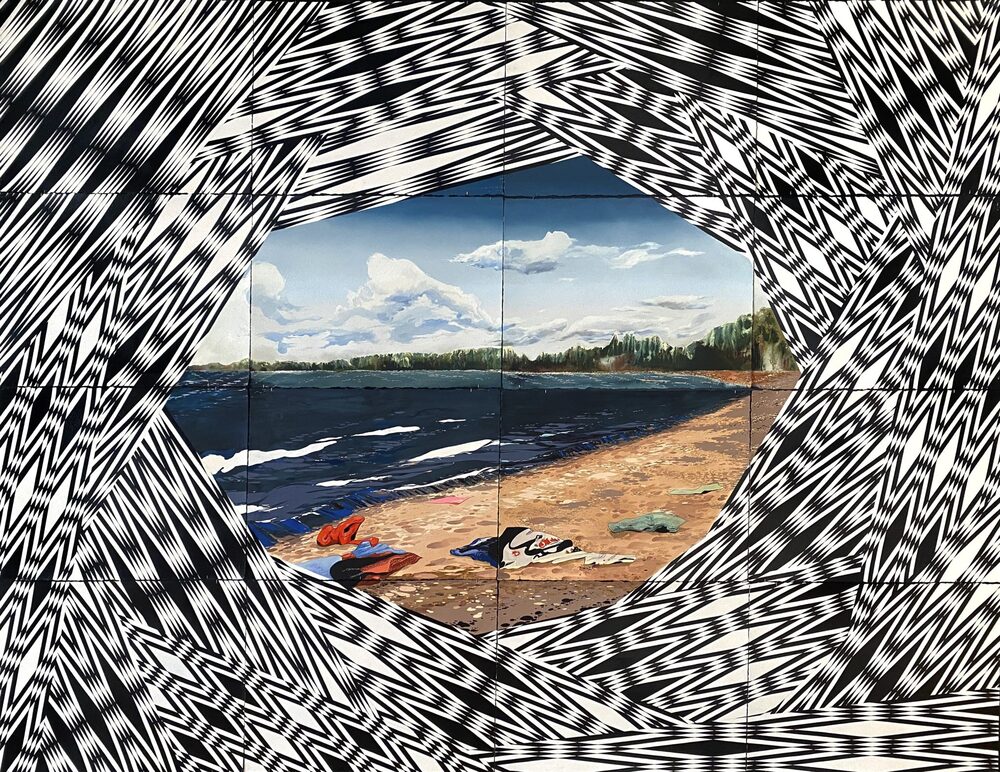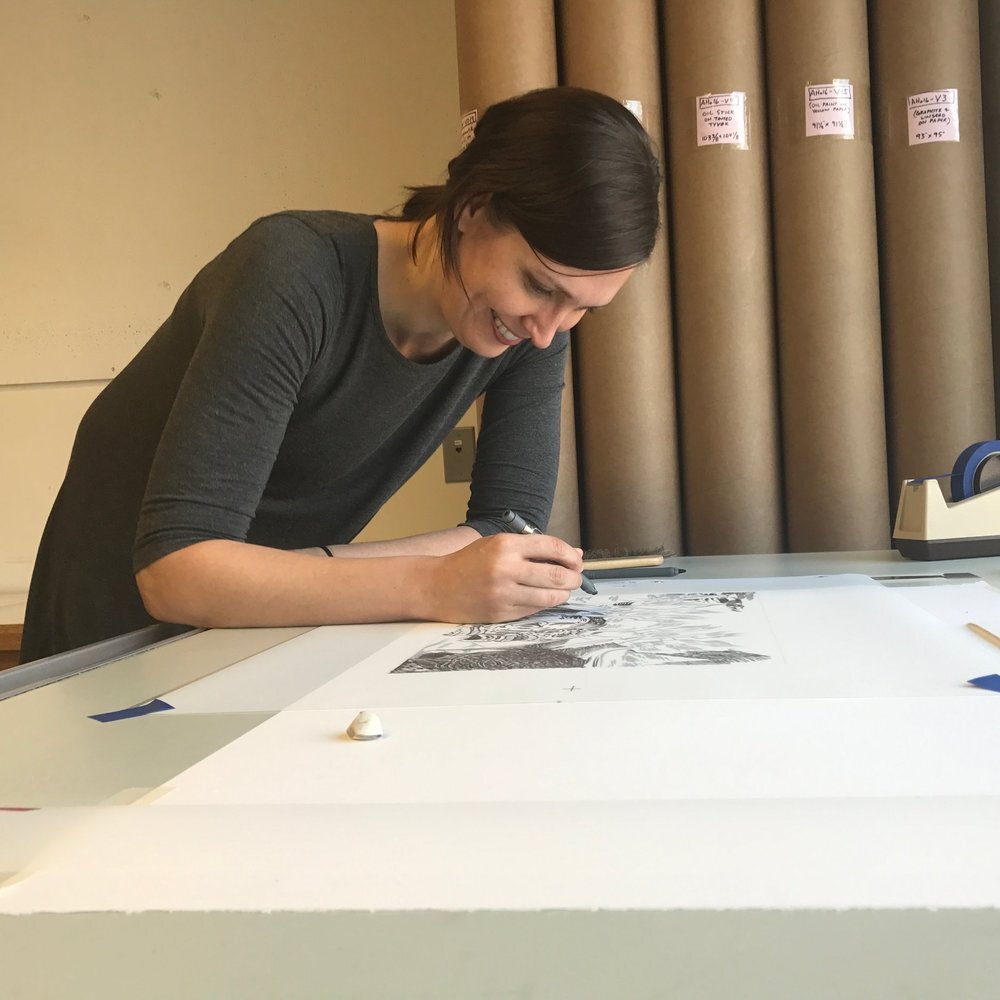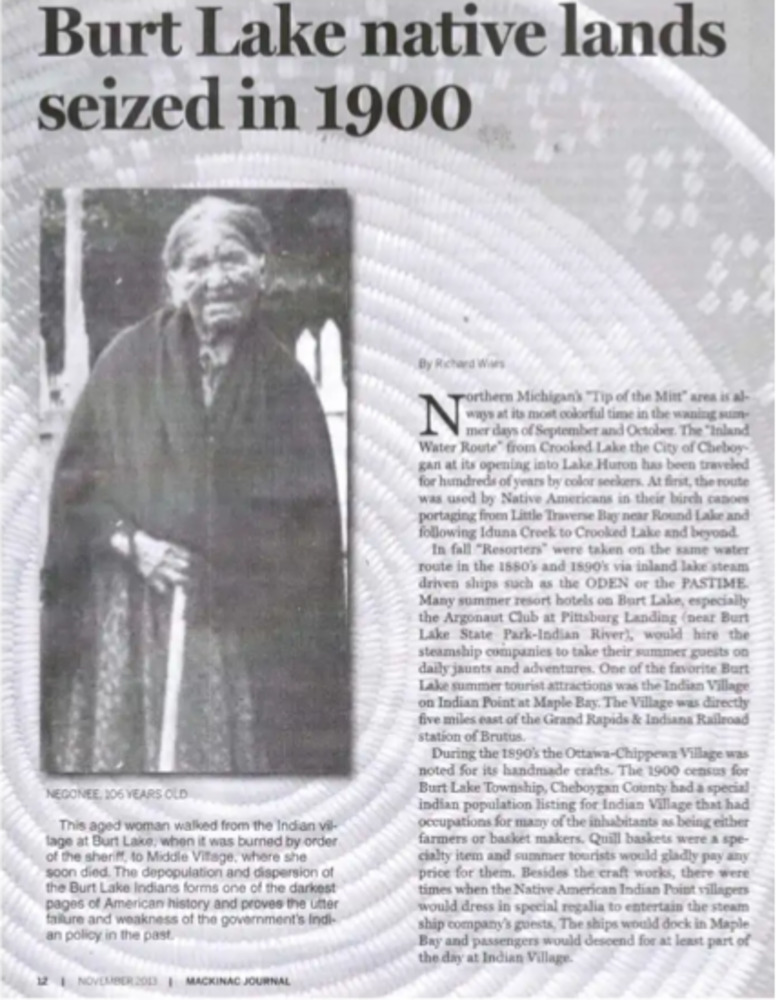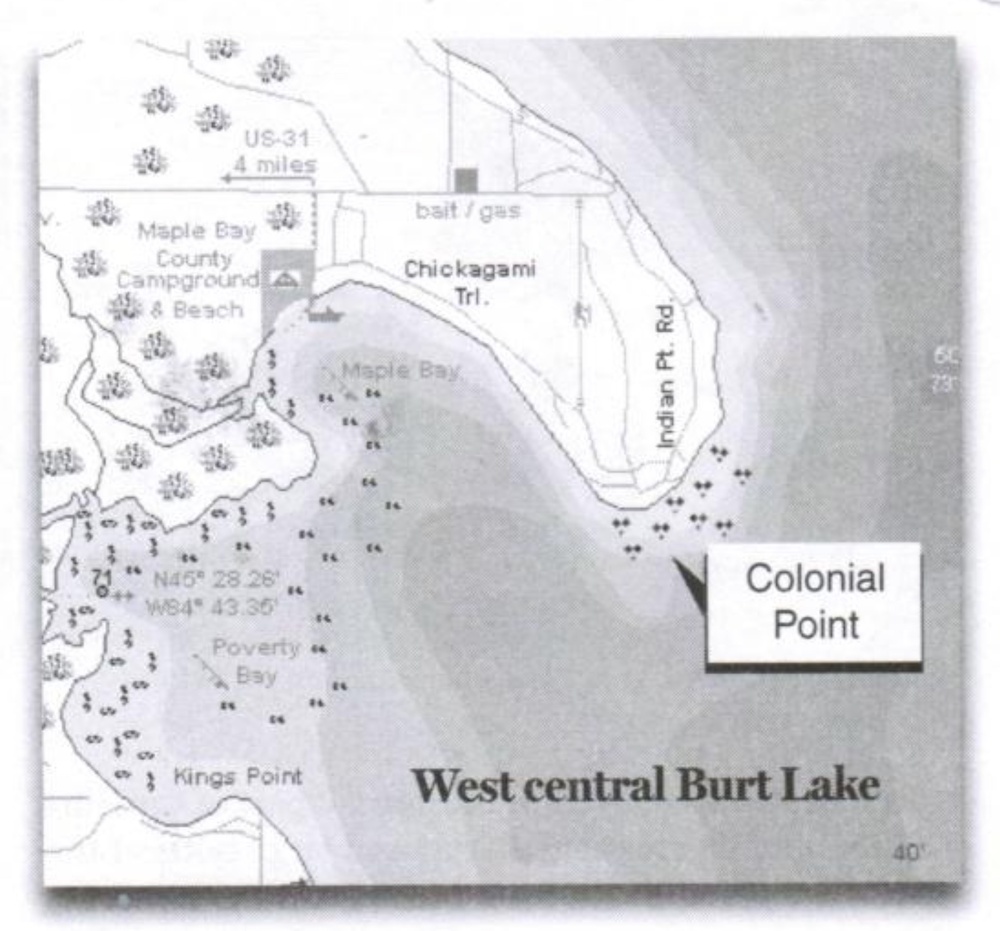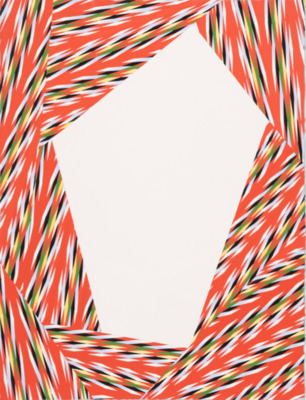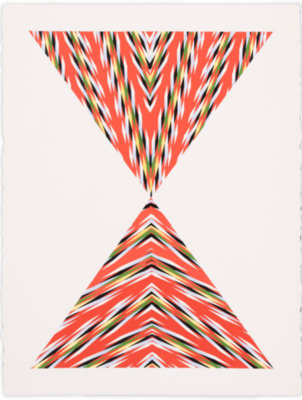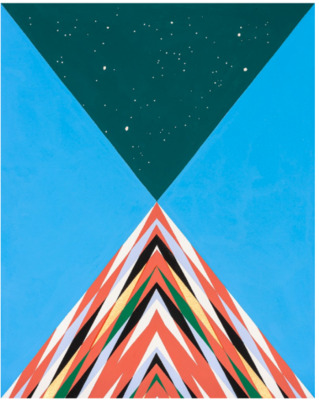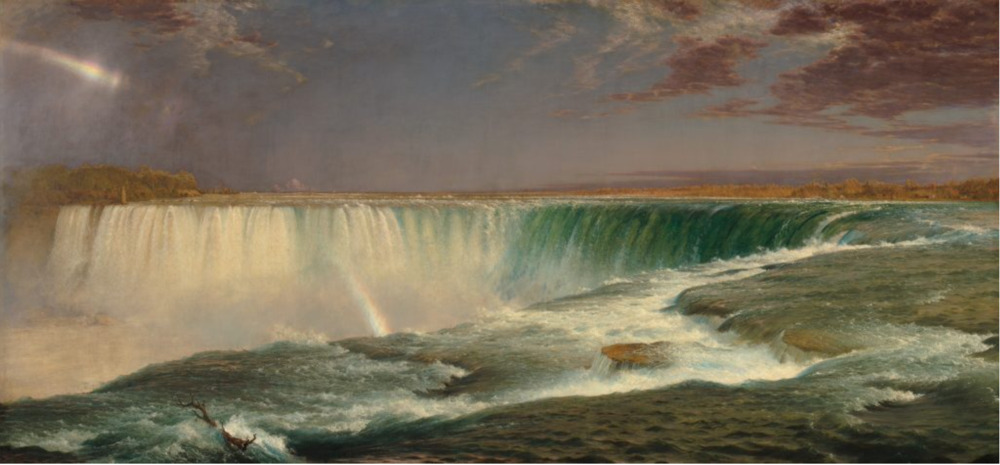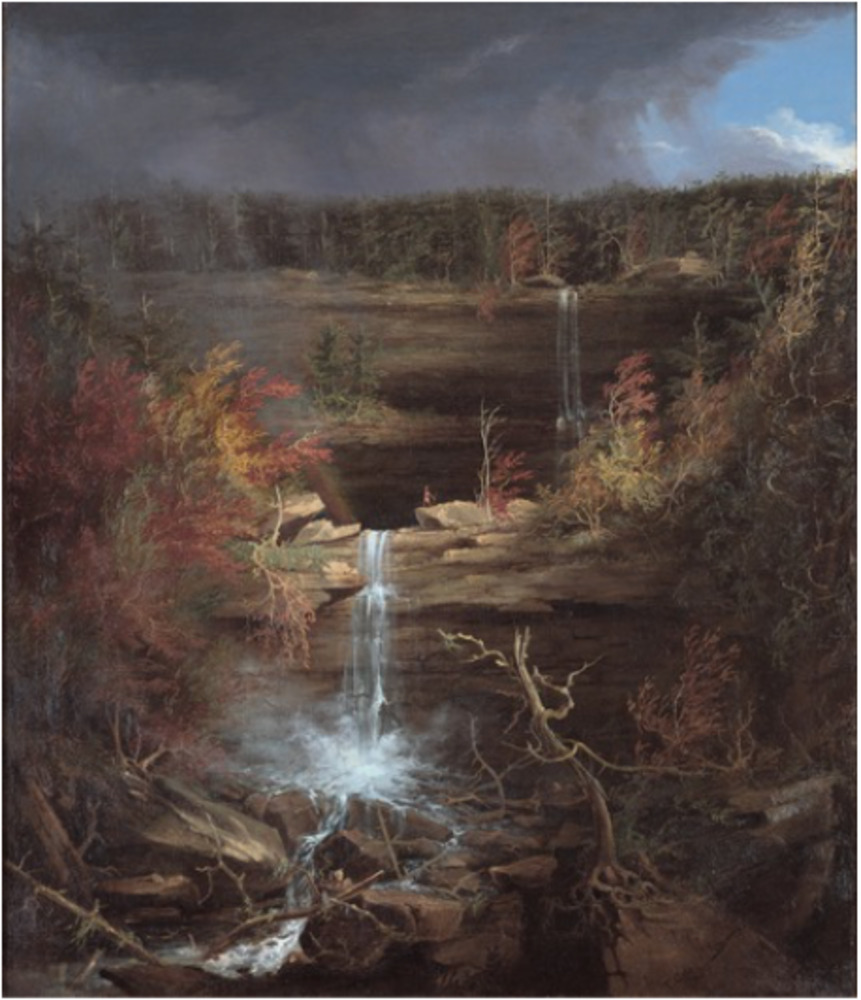REPRESENTING RESTORED REALITIES; AN ANALYSIS OF FUTURE CACHE BY ANDREA CARLSON
WRITTEN BY VICTORIA COBB, JAMES GERARD, AND ARDEN ROUSSEAUX
Introducing Andrea Carlson’s Future Cache, a modern adaptation of American Landscape painting for Indigenous justice:
A research report on Andrea Carlson's modern adaptations to 19th Century American landscape paintings, with context about the history of Michigan's Burt Lake Band of Ottowa and Chippewa Indians.
_______________________________________________________________________________
Biography of Andrea Carlson:
Written By James Gerard
Carlson's Social Activism Goals:
Written By Arden Rousseaux
Carlson transforms what could be a painting of any beach into a thought-provoking and visually entrancing experience. In doing so, “Future Cache” allows the audience to see through the lens of the Native American tribes who lost their beloved land. She achieves an emotional effect and conveys meaning in her work by considering the scale, assembly, colors, and perspective by using various visual elements, such as scale, perspective, and contrast of color and form. Carlson transports her audience into this imagined world in order to address past, present, and future social issues and inspire viewers to take steps toward sympathy and a desire for restorative justice. Although one can never truly or fully understand this without having experienced it, this painting conveys a piece of their loss and hope for their future.
___________________________________________________________________________________
Historical and Cultural Context:
Burt Lake Band of Indians and Colonial Point
Written By Arden Rousseaux
Burt Lake is located near the northern tip of Michigan’s lower peninsula in Cheboygan, MI. The Anishinaabe families lived here for many centuries. The U.S. federal government signed The 1836 Treaty of Washington, which allotted a 1,000-acre reservation on Cheboygan Lake and annual payments to the Cheboygan Band in exchange for 7 million acres for white settlements. When the government failed to uphold their end of the deal, the tribe purchased their own land on Indian Point in order to peacefully abide by the U.S. laws. Despite this, on October 15, 1900, the Burt Lake Band of Indians, comprises of men, women, and children of Ottawa and Chippewa Indians, were forced to evacuate the land that was their home. Cheboygan County Sheriff Fred Ming declared he was the owner of their land because of an illegal tax sale he made in 1900. He then led a group of men who forced the women and children out of their homes during pouring rain, and then set their village ablaze. As winter approached, twenty-five families were left homeless. They walked 35 miles in the pouring rain until they found shelter. This land has yet to be restored to its rightful owners, the Burt Lake Indians. Burt Lake is now a tourist area composed of mansions and wealthy residents.
___________________________________________________________________________________
Visual Analysis:
Written by James Gerard
The geometric patterns that surround the landscape painting create a hypnotic kind of 'portal effect' that looks inwards. Within that portal is a vast, extensive horizon that extends out of frame. This scene is of Burt Lake, but what stands now as a touristed beach site has nothing more than remnants of that commercial utilization. Towels, bathing suits, and beachgoer gear is scattered along the shore, with no sign of either the Anishinaabe or the colonists.The physical makeup of the artwork shows that it's broken into panels, perhaps to reflect the broken history of the Anishinaabe and of the land.
Written By Arden Rousseaux
The two main components of her painting, a colored landscape of a beach and a black-and-white geometric pattern, have a rich and important historical context. One is a rendition of a scene at Burt Lake, land formerly owned by the Burt Lake Band of Indians, while the other is a pattern inspired by Native American weavings in artwork and fabrics. Carlson imagines a better resolution to this story by painting the decolonization of the land that is currently a tourist beach.
The title, “Future Cache,” is important in interpreting the piece. “Future” situates the painting in a time that has not happened yet. Carlson does not showcase the past or present. Instead, she depicts a prospective world, which encourages viewers to consider what can be done to create this restored, envisioned future. “Cache” is a place to store or preserve important things, so perhaps the woven pattern was based on were caches that the Native Americans used to hold their treasures or supplies. This title illuminates that this land is one of the most sacred and significant things they had.
In the painting, no people are on the beach or in the water. However, there are remnants of the visitors who were once present: tourist’s towels and blankets are shown abandoned on the beach. Without these details, the land would appear pristine and untouched. The absence of people shows the restoration of this land, but the remnants left behind illustrate the consequences that affected the native tribes.
There is a great emphasis on the use of shapes and lines as a way to frame the image. The pattern overlaps at sharp angles to form an irregular nonagon, which serves as a border for the landscape. This structures the image by creating a heavy contrast between the two elements: the straight-edged, black and white pattern abruptly stops the flow of the colorful, organic forms held within its walls. Carlson emphasizes this division to draws her viewer's attention there, so they can begin contemplating the broader ideas of her work. This distinction is the first symbolic message, a suggestion of the Native American culture and people from their former land and home.
The geometric pattern also suggests depth as the border narrows from its widest edge on the canvas to the smaller polygonal shape around the beach. This illusion of concaving toward the center creates the feeling of looking inward at the landscape, as one would through a scope. This causes the landscape appeared distant and the viewer to feel separated from the beach from behind the border. This perspective alludes to the deeper, symbolic meaning. I interpreted it as looking inward through the lens of the tribes who lost their land to the white colonizers. A feeling of separation from this beautiful place they once called home—the duality of being intimately connected to a site but physically distant.
The large scale of the painting further heightens this effect. The scope is large enough to be interpreted as a portal to enter Carlson’s imagined world.
Another important aspect of the piece is the distinct appearance of being handmade. Carlson created the painting on twelve separate canvases that she joined in a 4x3 grid. From a distance, I could see the lines separating the pieces that came together to form the full image. Upon closer inspection, I noticed that the edges of the panels were rough, uneven, and “stitched” together by seemingly randomly placed metal staples. She could have painted it on one large canvas, which might have been easier, but she chose to have it fragmented. Perhaps this signifies the broken history of this land.
The scope or portal is through the dislocated feeling of the Native Americans looking back on the way of life they lost when they lost their land—overseeing what was once their sacred land, now a beach for tourists. While the perspective and scale create the feeling of physically being able to enter this realm, the realization that this is a painting stops viewers. Carlson’s handmade elements remind viewers that this is an imagined space one can never truly enter because it does not exist. This is another way to represent the tribe who last this land and their inability to re-inhabit their home.
__________________________________________________________________________________
Audience Reception in Publication and Media:
Written by Victoria Cobb
Future Cache is a commissioned piece from Andrea Carlson to the UMMA. The exhibit opened on June 11, 2022 and will be on display until June 1, 2024. This piece, paired with some of her other works stand proudly together, under a sign that reads, "You are on Anishinaabe Land". This is a powerful statement, as it brings to light the displacement of Native Americans from their land, as well as how that has become a forgotten part of history.
In addition to Carlson's success in the art world, Future Cache has also gained a lot of attention through media and publications. Many users on social media platforms have shared images and videos of the artwork, including some of the cultural significance it shows. The widespread attention of Future Cache speaks more broadly to the call for diversity and inclusive perspective in art and cultural landscape.
___________________________________________________________________________________
Carlson's Related Artworks:
Written by Victoria Cobb
Andrea Carlson had many works other than Future Cache. This specific piece was created by Carlson in 2017 as a way to show some traditional Native American pieces— such as baskets, beadwork, and quillwork— as if they were discovered in the future; A future where their makers and users have long since disappeared. She also mentions the use of the word cache, meaning it is a safe space to keep this piece of time and allow it to last for a future generation to see and learn from. Carlson also often incorporates more traditional native pieces in with the modern media she uses to create said pieces. This mix could be seen as a way for her to blend the two different ideas and perspectives into a common place where each can be respected and seen for what it represents.
In her other artworks, Carlson often ties in themes of colonialism, environmentalism, and the connection between indigenous people and the natural world. There is also a similar geometric pattern that wraps the Burt lake landscape, as seen in other pieces; This is a popular design that was often a signature used by Anishinaabe people. Her other works differ from Future Cache, however, through her use of muted colors. In her other works Carlson used very bright colors (such as red to make certain areas pop) and repeated areas over axes of symmetry. Overall, Future Cache is an important part of Carlson's broader body of work, which explores the complexities and contradictions of Indigenous and non-Indigenous cultures, histories, and identities in a contemporary context.
__________________________________________________________________________________
Art Historical Context and Contemporary Relevance:
Landscape painting Thomas Cole
Written by James Gerard:
Andrea Carlson’s depiction of Burt Lake in Future Cache seeks to tell stories of land that once served as the ancestral heart of the Anishinaabe people in the style of an idyllic postcard. Much like 19th century landscape artists, Carlson paints the Burt Lake panorama in a way that makes it seem larger than the frame. The immenseness of the landscape is similar to Frederic Edwin Church's painting Niagara, which utilizes the quality of a horizon that extends out of frame.
Carlson's depiction of Burt Lake shares a similar quality, where the tree-line in the background extends off into the right of the frame, interrupted by the geometric patterns. The lake itself, in contrast, extends off to the left, leaving the shoreline at the center of attention where the debris of colonial leisure lies.
Much like Thomas Cole’s Kaaterskill Falls, the “oneness” between Native People and their land is an important facet of the painting. Cole’s painting includes a Native American looking towards the sky, whereas Carlson’s rather removes the colonists altogether and implies their nonexistence. But, both admire the existence of land devoid of commercialized use.
What's interesting in Cole's painting is that, in the early 1800s, the Kaaterskills were a touristed area, much like Burt Lake, that interrupted the lives of Indigenous people. While Cole paints the Native American with strong posture and is surrounded by the landscape, almost engulfed in it. Carlson's painting reimagines a future that does away with tourism, leaving behind debris in the same way the Burt Lake burnout forced the Anishinaabe to leave without a chance to pack their own belongings. The contrasting interpretation of that tourism makes Carlson's assessment of colonialism seem more provocative and critical. The revisitation to those forgotten stories of imperial violence, however, are significant in understanding the future of land justice.
___________________________________________________________________________________
Annotated Bibliography:
Andrea Carlson's Website - Contains works, information abou the artist, and Carlson’s personal blog. This provides some insight into who she is as a person, and how that influences the work she creates.
Bockley Gallery - Contains a brief description of Future Cache and leads into the YouTube video 'Wholeness In The Future' (a presentation with Andrea Carlaon through the Penny Stamps distinguished speaker series at the University of Michigan).
UMMA Future Cache - Includes the University’s description of the piece and links to get more information of the Native American background Andrea has and uses in her art.
Joan Mitchell Foundation - This includes a quote from Carlson that shows a bit more insight into her art. Especially interesting how she uses “cultural cannibalism” as a way to describe what has happened in the past to her culture, and how that still continues today. There’s also a brief overview of her career.
Future Cache Analysis - The title is a reference to how the Anishinaabe would store supplies in underground caches through the different seasons. Could be interpreted as looking through a lens (geometric pattern) and seeing what little (clothes) is left behind by humans. Includes some analysis of Future Cache by the UMMA curator, Jennifer Friess.
Created For
K-12 EducatorK-12 Student
Museum Visitor
UMMA Docent
UMMA Staff
University Faculty
University Student
Rate this Resource
AVG: 5.0 | Ratings: 1
& Author Notes
All Rights ReservedLast Updated
April 25, 2023 8:28 a.m.Report
Reporting Policy
